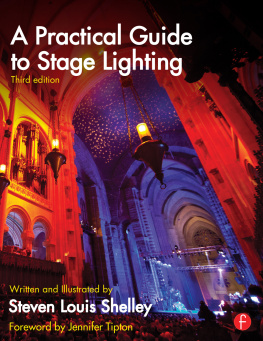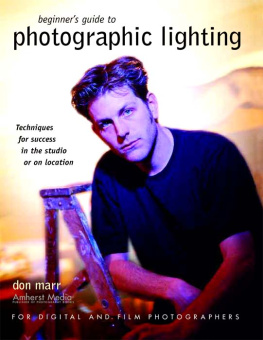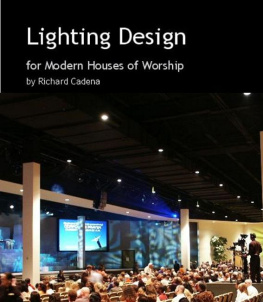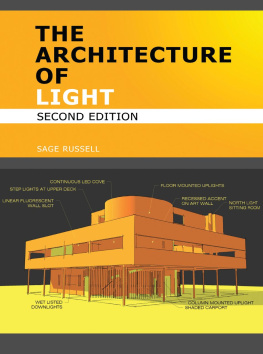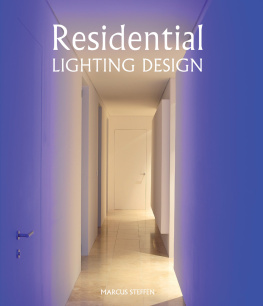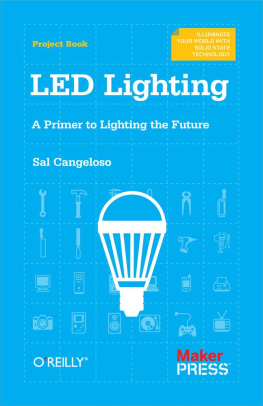A Practical Guide to Stage Lighting Third Edition
Steven Louis Shelley

First published 1999 by Focal Press
This edition published 2014
by Focal Press
70 Blanchard Road, Suite 402, Burlington, MA 01803
Simultaneously published in the UK
by Focal Press
2 Park Square, Milton Park, Abingdon, Oxon OX14 4RN
Focal Press is an imprint of the Taylor & Francis Group, an informa business
2014 Steven Louis Shelley
The right of Steven Louis Shelley to be identified as author of this work has been asserted by him in accordance with sections 77 and 78 of the Copyright, Designs and Patents Act 1988.
All rights reserved. No part of this book may be reprinted or reproduced or utilised in any form or by any electronic, mechanical, or other means, now known or hereafter invented, including photocopying and recording, or in any information storage or retrieval system, without permission in writing from the publishers.
Notices
Knowledge and best practice in this field are constantly changing. As new research and experience broaden our understanding, changes in research methods, professional practices, or medical treatment may become necessary.
Practitioners and researchers must always rely on their own experience and knowledge in evaluating and using any information, methods, compounds, or experiments described herein. In using such information or methods they should be mindful of their own safety and the safety of others, including parties for whom they have a professional responsibility.
Product or corporate names may be trademarks or registered trademarks, and are used only for identification and explanation without intent to infringe.
Library of Congress Cataloging in Publication Data
Shelley, Steven.
A practical guide to stage lighting / Steven Louis Shelley. -- Third edition.
pages cm
Includes bibliographical references and index.
ISBN 978-0-415-81200-9 (Paper back) ISBN 978-0-203-55327-5 1. Stage lighting. I. Title.
PN2091.E4S52 2013
792.025dc23
2013012974
ISBN: 978-0-415-81200-9
ISBN: 978-0-203-55327-5
Typeset in Bembo Std
By MPS Limited, Chennai, India
www.adi-mps.com
Table of Contents
A Practical Guide to Stage Lighting is intended for readers who want to understand the process and the tools used in theatrical lighting design.
This book is not written for the person only beginning to study theatrical lighting design. Theres more introductory information that needs to be understood and practiced than can be presented in the Review, and there are many other texts that provide that.
Likewise, this book is not written for those who want to learn about more specialized topics, such as designing lights for television, film, or concerts. While a lot of information is included in this book, those topics arent mentioned. There are also no examinations of touring, intimate discussions about moving lights, the latest how-to for visualization programs, or inside dope on designing for Broadway. There are other books that cover those topics as well.
A Practical Guide to Stage Lighting is intended for the young designer who has some understanding of the lighting design process, the more experienced designer who is interested in viewing different techniques, or the mature designer who just keeps forgetting the list of things to remember. While Ive been all of those designers, I now firmly place myself in the last category. This book got started long ago when it dawned on me how helpful lists could be. Im not ashamed to admit that Ive referred to this book numerous times before embarking on a process that I havent encountered for a while.
This book includes a lot of different forms and ways to present information that, if nothing else, may be useful as templates. Every show is different, and I believe it is the rare production that will actually need every one of these forms. Likewise, just because a particular form appears in these pages doesnt necessarily mean the lighting designer should be the one making it. These forms are included because they somehow impact the lighting designer or the lighting design. When it comes to schedules or other interdepartmental forms, hopefully someone else can take responsibility for it.
While many of the methods and techniques I describe in this text are not the only way to achieve the desired end, they are the simplest ways Ive found to successfully reach it. In some cases, those methods are presented merely as suggestions. Sometimes, theyre strongly suggested. And in particular cases, they are ironcladthose are the Golden Rules.
To make it easy to distinguish one from the other, several icons are included to highlight portions of this book.

Checklist: This icon indicates a list of items. Although not every item is necessarily applicable to every situation, the list can be reviewed prior to addressing the task at hand.

Shelleys Notes: This icon points to notes based on my own experiences. Theyre included so others dont have to make the same mistakes I did.

Sneaky Tip: This icon indicates a piece of information that was a revelation when it was presented to me.

Shelleys Soapbox: This icon marks my own strong personal opinion.

Shelleys Golden Rule: This icon highlights a particular fact, situation, or method that Ive found to be irrefutable.

Tales from the Road: This icon is used for stories. While the tire track implies the story is from the road, it also indicates the impression thats left after being run over. Thats often how one feels after learning a painful lesson.
At last. The third edition of the book that we in the theatrical lighting world have been waiting for has arrived. This new, greatly expanded edition includes a wealth of additional information, stepping through the design process from the beginning (contracts, budgets, bids, production schedules), through development of the plot and tech rehearsal, and on to the end (archiving). It includes helpful discussions of such disparate topics as what to do about transport, how to approach meetings, or how to cope with changes during load-in or tech. Whether you are a lighting designer on Broadway, Off-Broadway, in LORT theatres, for small or large dance companies who tour or give one-time performances, or for any kind of theatrical venture, ...
In my experience, there are three defining moments in the course of any lighting design. The first is when the lighting designer is hired. The second is when the load-in starts and lighting instruments begin to get hung. The third and final moment is when the curtain opens to an audience.
In between, the realization of every lighting design requires a progressive sequence of tasks. In addition to completing the tasks, every design has to be adaptedno design is ever realized without some amount of change. Not only is every production unique, the final product may be completely different from the initial plan. In order for a design to be considered complete, both the initial tasks and the adaptations must be executed.

